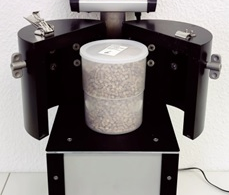Ash from biomass power plants analyzed with Lab Scout
When biomass is burned, the non-combustible components of a large volume are concentrated in a small volume of ash. Large amounts of ashes from biomass power plants are usually used as additives for cement production.
Plants absorb dissolved radioactive substances from the soil through their nutrient cycle. This applies in particular to the easily soluble, naturally occurring radium isotopes of the uranium and thorium decay series, the potassium isotope K-40 and the cesium isotope Cs-137.
As a result of the Chernobyl reactor accident, large amounts of Cs-137 were distributed primarily in northern, eastern and southern Europe and parts of Central Europe and stored in the upper soil layers. Due to its low mobility, the concentration decreases only very slowly. Some of the countries affected are among the largest European wood producers, so it must be assumed that large quantities of contaminated wood and wood waste are used as fuel.
With the cement, the radionuclides enter the immediate human environment in a concentrated form, e.g. as plaster and screed. The consequences are an increased local dose rate but also the emanation of radon. Measurements have shown that exceeding the legal radon reference value is due to radon emanation from cement products.
Due to the different origins of the biomass, the activities and ratios of the different isotopes in the ash are subject to strong fluctuations. A continuous and rapid test procedure is therefore required for controlled transfer.
With the Lab Scout , expensive and time-consuming laboratory analyzes can be replaced by a quick "on-site" measurement.
The measurement method delivers reliable measurement values for the sample type and the observed activity ranges even with measurement times of one hour. For the Cs-137 activity determination, the Lab Scout with the Lab Scout Works operating software meets the requirements of a fast method for the analysis of ash samples from biomass power plants.
A month-long campaign showed that no calibration or maintenance work was necessary. This in turn shows that the measuring device can generally be operated with very little effort in terms of personnel and material.



